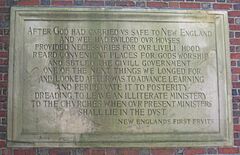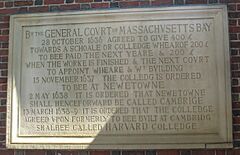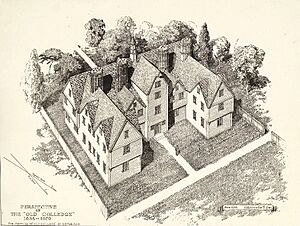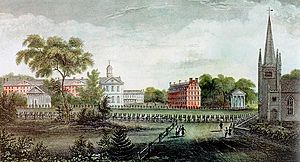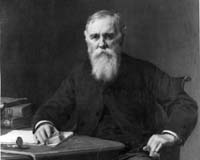History of Harvard University facts for kids
The history of Harvard University began in 1636. It was founded as Harvard College in a young settlement called New Towne, Massachusetts. This town had been settled just six years earlier in 1630. New Towne was officially organized as a town when the college was founded. Two years later, its name changed to Cambridge, Massachusetts, honoring a city in England. Harvard is the oldest university in the United States.
In the late 1700s, Harvard started offering advanced degrees. It then became known as Harvard University. The name Harvard College began to refer only to its undergraduate program. Harvard's reputation grew from national to international. Many graduate and professional schools were added alongside the original undergraduate college. Important schools that influenced the nation include medicine (1782), law (1817), and business (1908). The Harvard Graduate School of Arts and Sciences (1890) also became very important.
For many centuries, Harvard graduates held important positions in Massachusetts, especially as religious leaders and government officials. Since the late 1800s, Harvard has been one of the most respected schools in the world. It has the largest library system and the biggest financial fund of any university.
Contents
Founding Harvard College
By 1636, about 17,000 Puritans had moved to New England. Harvard was founded because they knew they would need trained religious leaders for their new community. It was established in 1636 by a vote of the Great and General Court of the Massachusetts Bay Colony. In 1638, the school received a printing press. This was the only press in what is now the United States at that time. Harvard got a second press in 1659.
On March 13, 1639, the college was renamed Harvard College. It was named after John Harvard, a religious leader. He had studied at the University of Cambridge in England. John Harvard left the new school £779 pounds sterling and his library of about 400 books.
In the 1640s, Harvard College started the Harvard Indian College. This college aimed to educate Native American students. Only a few students attended, and only one graduated.
The colony's official document creating the Harvard Corporation was granted in 1650. This was at the start of the English Interregnum period. Harvard's first president, Henry Dunster, changed his religious beliefs in 1654. He left the Puritan faith for the English Baptist faith. This caused a big argument. It showed two different ways the Massachusetts Bay Colony dealt with people who disagreed. Puritan leaders usually tried to work things out with those who questioned their beliefs. But they were much harsher on those who completely rejected Puritanism.
Dunster's problem with the colony's leaders began when he did not baptize his baby son. As a Baptist, he believed only adults should be baptized. Efforts to make Dunster return to Puritan beliefs failed. His change in faith was unacceptable to the colony's leaders. They had trusted him to uphold the colony's religious mission as Harvard's president. So, he was seen as a threat to society's stability. Dunster left in 1654 and moved to nearby Plymouth Colony. He died there in 1658. Later, in 1684, King Charles II canceled the Massachusetts Bay Colony charter. This was because it had been illegal for the colony to establish a college.
In 1692, a leading Puritan religious figure, Increase Mather, became president of Harvard. He replaced ancient Greek and Roman books with Christian authors in ethics classes. He also made sure discipline was very strict. The Harvard "Lawes" of 1642 and the "Harvard College Laws of 1700" show how strict it was. Students had to follow rules of religious behavior that would be unusual later on. To get a bachelor's degree, they had to show they could "read the original of the Old and New Testament into the Latin tongue, and resolve them logically." Harvard's leaders and former students, including Increase Mather and his son Cotton Mather, played a big part in the Salem Witch Trials from 1692 to 1693.
The town of Dedham was founded in 1636, the same year as the college. The first minister of the First Church and Parish in Dedham, John Allen, helped oversee Harvard. Every minister there until 1861 was connected to the university. Dedham, despite its small size and limited money, gave generous support to the college. Allen even donated two cows, probably for milk for the president and teachers.
In Harvard's early years, the town of Cambridge helped keep order on campus. It also provided financial support. The local Puritan minister directly oversaw Harvard. He made sure its leaders followed the correct religious beliefs. By 1700, Harvard was strong enough to manage its own people and rules. The flow of support reversed. Harvard now provided money for local economic growth. It also helped improve public health and build local roads, meetinghouses, and schools.
Harvard in the 1700s
Harvard's early motto was Veritas Christo et Ecclesiae. This means "Truth for Christ and the Church." In the first classes, half of the graduates became ministers. By the 1760s, this number dropped to 15%. Ten of Harvard's first twelve presidents were ministers. Formal religious teaching began in 1721. By 1827, Harvard became a center for religious education in New England.
The end of Mather's presidency in 1701 started a long struggle. It was between traditional religious beliefs and more liberal ideas. Harvard's first president who was not a minister was John Leverett. He started his term in 1708. Leverett mostly kept the school's courses the same. He tried to keep the college independent from too much influence from any single religious group.
During the American Revolution, there were many more Patriots than Loyalists among Harvard's former students. Seven Harvard alumni died fighting for the Patriots.
Harvard in the 1800s
| College/school |
|
| Harvard College |
|
| Medicine |
|
| Divinity |
|
| Law |
|
| Dental Medicine |
|
| Arts and Sciences |
|
| Business |
|
| Extension |
|
| Design |
|
| Education |
|
| Public Health |
|
| Government |
|
| Engineering & Applied Sciences |
|
New Ideas and Science
Throughout the 1700s, new ideas about reason and free will became popular. These ideas came from the Age of Enlightenment. They spread among ministers, causing tension with more traditional groups. In 1803 and 1804, two important Harvard leaders died. A struggle began over who would replace them. In 1805, Henry Ware was chosen for a key teaching position. Two years later, the liberal Samuel Webber became Harvard's president. This showed a shift from traditional ideas to more liberal ones at Harvard.
In 1846, Louis Agassiz gave popular lectures on natural history at Harvard College. Agassiz believed in combining observation with intuition in science. He thought people could understand a "divine plan" in nature. His ideas were popular because they fit with other philosophical teachings at Harvard.
Changes in Student Body
Between 1830 and 1870, Harvard became more "private." When the Federalist Party lost power in Massachusetts, the state stopped funding private universities like Harvard. By 1870, politicians and ministers on the university's board were replaced. They were replaced by Harvard alumni from wealthy business and professional families in Boston. These alumni funded the university with private donations.
During this time, Harvard grew greatly. It became financially stronger than other American colleges. In 1850, Harvard's total money was five times more than Amherst and Williams colleges combined. It was also three times more than Yale. People started sending their children to Harvard for its social benefits. Under President Eliot, Harvard became known as more open and fair than Princeton or Yale. This was especially true regarding prejudice against Jewish people and other minority groups. In 1870, Richard Theodore Greener became the first African-American to graduate from Harvard College. Seven years later, Louis Brandeis, the first Jewish justice on the Supreme Court, graduated from Harvard Law School. Still, Harvard remained a place for a specific Protestant elite, known as the Boston Brahmin class, well into the 1900s.
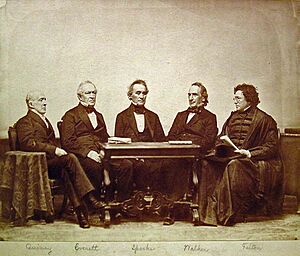
The yearly undergraduate tuition was $300 in the 1930s. It was $400 in the 1940s. It then doubled to $800 in 1953. By 1970, it reached $2,600, and in 2000, it was $22,700.
President Eliot's Influence
Charles W. Eliot was president from 1869 to 1909. He removed the special status of Christianity from the curriculum. He also allowed students more freedom in choosing their studies. Eliot was very important in making American higher education less focused on religion. But his goal was not to remove religion. He was inspired by his Unitarian beliefs. These beliefs focused on the importance of human nature. They also emphasized each person's ability to find truth and the idea of God within each person.
Sports at Harvard
Football was first started by students as an activity outside of classes. The university banned it twice because it was seen as too rough and dangerous. However, by the 1880s, football became very popular at the college. Former students became more involved in the sport. In 1882, the faculty created a three-person committee to oversee all sports between colleges. But due to pressure from students and alumni, the committee grew in 1885. It then included three students and three alumni. The alumni played a big role in football's growth and its commercial success. Football became the top money-maker for sports by the 1880s. This was clear in the fundraising for the first steel-reinforced concrete stadium. The class of 1879 donated $100,000, which was almost one-third of the cost. The 35,000-seat stadium was finished in 1903. The rest of the money came from future ticket sales.
Modern Language Studies
Programs for studying French and Spanish began in 1816. George Ticknor was their first professor.
Harvard in the 1900s
During the 1900s, Harvard's global reputation for academic excellence grew. Its increasing financial fund and famous professors expanded the university's reach. The student population grew rapidly. New graduate schools were added, and the undergraduate program expanded. Harvard built the world's largest and best academic library. It also built the labs and clinics needed to make its science departments and Medical School famous. The Law School competed with Yale Law for top honors. The Business School combined a large research program with a focus on entrepreneurs. The different schools are financially separate. They each have their own large funds. The college/Faculty of Arts and Sciences, Business, Law, and Medical Schools have very large funds. The Divinity and Education schools have more modest funds.
Radcliffe College was started in 1879 as a sister school to Harvard College. It became one of the most important schools for women in the United States. In the 1920s, Edward Harkness, a Yale graduate with oil wealth, offered money to Yale. When Yale ignored him, he gave $12,000,000 to Harvard. This money was to create a house system like Oxford University's. Yale later accepted his money and set up a similar system.
Besides the usual departments, many special research centers appeared. These centers helped with research projects that involved many different subjects. However, departments kept strict control over who received permanent teaching positions. Usually, these positions went to people from outside Harvard, not to assistant professors who were promoted. Older research centers include the East Asian Research Center and the Russian Research Center. These centers raised their own money, often from government and foundation grants. This made them more independent.
During World War II, Harvard was one of 131 colleges and universities that joined the V-12 Navy College Training Program. This program offered students a way to become Navy officers.
The yearly undergraduate tuition was $300 in the 1920s. It was $400 in the 1930s. It then doubled to $800 in 1953. By 1970, it reached $2,600, and in 2000, it was $22,700.
Fairer Admissions
James Bryant Conant was president from 1933 to 1953. He promised to make Harvard a leader in creative research again. Conant believed that higher education should be for talented people, not just the wealthy. He created programs to find, recruit, and support talented young people. In 1943, Conant decided Harvard's undergraduate courses needed to change. He wanted more focus on general education. He asked the faculty to define what general education should be for both high school and college. The Report published in 1945 was very influential in American education during the 1900s.
After 1945, Harvard changed its admissions rules. It wanted students from a wider range of backgrounds. Before, Harvard undergraduates were mostly wealthy students from certain New England "feeder schools." These included Exeter and Milton Academy. But by the late 1960s, more international, minority, and working-class students changed the college's student body.
Not only students, but also the faculty became more diverse. Harvard became more willing to hire Jewish, Catholic, and foreign scholars. The History Department was one of the first to hire Jewish professors. This helped the university become more professional from 1920 to 1950. Oscar Handlin became a very influential professor. He trained many graduate students and later led the University Library.
During the 1900s, Harvard's international reputation grew. Its growing financial fund and famous professors expanded the university's reach. The student population grew rapidly. New graduate schools were added, and the undergraduate program expanded.
Women at Harvard
In 1945, Harvard Medical School accepted its first class of women. A special committee decided that male students would benefit from seeing women as equals. They also thought that women doctors could help in lower-paying medical fields that men often avoided. And they believed that the weakest male students could be replaced by a better group of women.
For its first fifty years, Radcliffe College was known as the "Harvard Annex for Women." It was established in 1879. Radcliffe paid Harvard faculty to repeat their lectures for female students. During World War II, male and female undergraduates attended classes together for the first time. However, it took many decades for Radcliffe College to have as many students as Harvard. In the 1970s, Harvard and Radcliffe made two agreements. Harvard became responsible for almost all undergraduate matters for women. This included admissions, advising, teaching, housing, student life, and sports. Women were still formally admitted to and graduated from Radcliffe. But in 1979, Radcliffe officially merged with Harvard. This created the Radcliffe Institute for Advanced Study.
In 2006, Lawrence Summers resigned as president. This happened after he made comments about why women might be underrepresented in top science jobs.
In 1984, Harvard stopped its official ties with undergraduate "final clubs." This was because these clubs refused to admit women. As of 2016, Harvard prevented members of single-sex organizations from holding campus leadership roles. These roles included team captaincies. They also could not receive recommendation letters from Harvard for scholarships like the Marshall Scholarship and Rhodes Scholarship. After a Supreme Court ruling in June 2020, Harvard changed this policy.
Harvard's Graduate Schools
Medical School History
The Harvard Medical School is the third-oldest medical school in the United States. It was founded in 1782 as Massachusetts Medical College. It was started by John Warren, Benjamin Waterhouse, and Aaron Dexter. In 1810, it moved from Cambridge across the river to Boston. The medical school was only loosely connected to the rest of the university. But its strong faculty gave it a national reputation by the early 1800s.
The medical school moved to its current location on Longwood Avenue in 1906. There, the "Great White Quadrangle" or HMS Quad was built. It has five white marble buildings.
Its reputation continued to grow in the 1900s. This was especially true for scientific research. It also received support from wealthy people in the region and nation. Fifteen scientists won the Nobel Prize for work done at the Medical School. Its four main teaching hospitals are Beth Israel Deaconess Medical Center, Brigham and Women's Hospital, Boston Children's Hospital, and Massachusetts General Hospital.
Law School History
The Harvard Law School was established in 1817. This was possible because of a gift from Isaac Royall Jr. in 1779. It is the oldest continuously operating law school in the nation. It started small and grew slowly. By 1827, it had only one faculty member. Nathan Dane, a well-known former student, gave money to create the Dane Professorship of Law. He insisted it be given to then-Supreme Court Justice Joseph Story. For a while, the school was called Dane Law School. Story believed in the need for an excellent law school. He thought it should be based on merit and dedicated to public service. This helped build the school's reputation at the time. Enrollment remained low. This was because academic legal education was not seen as very helpful compared to learning through apprenticeships.
Big changes came in the 1870s under Dean Christopher Columbus Langdell (1826–1906). His new way of teaching became the national standard. It was copied widely in the United States. Langdell developed the casebook method of teaching law. He believed law could be studied like a "science." This gave university legal education a reason to exist apart from just training for a job. The school introduced a first-year curriculum that was widely copied. It was based on classes in contracts, property, torts, criminal law, and civil procedure.
Some critics disliked giving up the older lecture method. They thought lectures were more efficient and meant less work for teachers and students. But supporters of the case method had a stronger basis in scientific research. Langdell's graduates became leading professors at other law schools. They introduced the case method there. From its founding in 1900, the Association of American Law Schools promoted the case method. This was for law schools that wanted to be officially recognized.
Graduate School of Arts and Sciences
As the college modernized in the late 1800s, the faculty was organized into departments. They began to add graduate programs, especially the PhD. Charles William Eliot, president from 1869 to 1909, was a chemist. He had spent two years in Germany studying their universities. Thousands of Americans, mostly Harvard and Yale alumni, had attended German universities. Eliot used the German model to set up graduate programs at Harvard. He formed a graduate department in 1872. It granted its first Ph.D. degrees in 1873. William Byerly earned one in mathematics, and Charles Whitney in history. Eliot set up the Graduate School of Arts and Sciences in 1890. It had its own dean and budget. It handled graduate students and funded research programs.
By 2004, there were 3,200 graduate students in 53 different programs. Forty former or current professors had won a Nobel Prize. Most of them were scientists or economists in the Graduate School of Arts and Sciences.
Business School History
From its start in 1908, the Harvard Business School had a strong connection with the business world. Within a few years, many business leaders were its former students. They hired other alumni for entry-level jobs in their companies. The School used money from the Rockefeller family in the 1920s. This was to start a big research program under Elton Mayo (1926–1947). His "Harvard human relations group" made discoveries that changed how human relations were viewed in business. This raised the Business School's reputation. It went from being seen as just a place to train "money grabbers" to a respected educator of socially responsible leaders. Starting in 1935, the school began offering weekend and short-term leadership training workshops. These were for executives of major companies. This further expanded its national role.
By 1949, almost half of all people with an MBA degree in the U.S. were alumni of the Business School. It was "the most influential graduate school of business."
Harvard Kennedy School
In 1936, Harvard University founded the Harvard Graduate School of Public Administration. It was later renamed the Harvard Kennedy School. This was in honor of former U.S. President John F. Kennedy. He was a 1940 graduate of Harvard College. The Kennedy School had a financial fund of $1.7 billion in 2021. It is often ranked among the top graduate schools in the world. This includes studies in public policy, social policy, international affairs, and government. Its former students include 17 heads of state or government.


